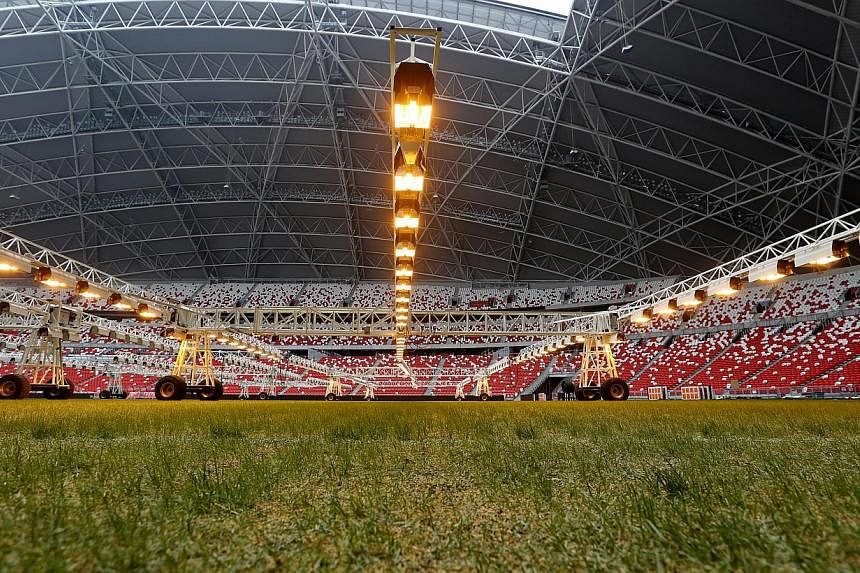The new National Stadium, centrepiece of the $1.33 billion Singapore Sports Hub, will host Tuesday's football friendly between five-time World Cup winners Brazil and Asian champions Japan before what is likely to be a sellout crowd of 55,000.
But it has drawn sharp criticism over the less than ideal state of its sandy, patchy pitch, slammed for being well below international standards.
In an interview with The Sunday Times, Singapore Sports Hub chief operating officer Oon Jin Teik acknowledged the problems and said no effort is being spared to set things right.
"We are sorry that it is not as good as it should be," said Mr Oon. "Along the way, there will be foul-ups - we are still a very raw venue. But I want a good field more badly than our harshest critics."
Last Thursday, the Football Association of Singapore declared the hybrid surface comprising natural grass woven with synthetic fibres "fall short of the expected international playing standards". That was after the Asean Football Federation (AFF) and Sport Singapore, a statutory board of the Ministry of Culture, Community and Youth, had expressed concerns about the venue being fit to host the AFF Suzuki Cup next month.
While inspections have deemed the field "playable", sandy patches and a less than lush field make for a poor playing surface which looks even worse on television.
In August, Italian giants Juventus, who played a Singapore Selection there, said the pitch was not "100 per cent safe" and did not field stars such as Carlos Tevez as a precaution.
Fans fear Tuesday's friendly may see the withdrawal of top names like Brazil's Neymar and Japan's Keisuke Honda.
But the Sports Hub said it is pulling out the stops and working round the clock to fix the flaws.
To stimulate the growth of its rye and blue grass seeds, $1.5 million worth of special lighting equipment was installed recently. The lights, hovering slightly over a metre above ground, are kept on through the night to act like sunlight.

Mr Oon insisted that "no expense will be spared" as the Sports Hub seeks a solution ahead of more than 100 football, rugby, cricket, athletics and entertainment events expected to be held at the multi- purpose venue each year. Since opening in June, the stadium has hosted a range of events.
"We can't compare it to the old National Stadium which had a pristine field because it held only football games," he said. "Singaporeans wanted more sporting events, so we need a field to be rugged and durable enough for heavy programming."
He insisted that even though "it doesn't look pretty", the field is good enough to be used in its current state.
But he said that there were unexpected problems with the facility's "micro-climate" - where high humidity combined with the unique high-sided, closed-roof structure limited sunlight and ventilation to affect the growth of the grass.
"No other stadium in the world has dealt with this combination of challenges," he said.
"We tested over 20 types of grass during a 15-month-long process, but when all the variables come together in one place, it becomes an exact science to get right.
"Even the relatively basic task of watering the field is challenging because it doesn't dry fast enough - we have to use special fans, otherwise the leaves will get diseased."
When the field is finally in perfect condition, the stadium's $860,000 Desso GrassMaster system - which embeds hundreds of millions of artificial fibres to natural grass to make the field more durable - promises to create a surface that will mirror those in top stadiums in Europe. The fibres help anchor the pitch and create a solid, even structure with sufficient drainage to withstand Singapore's torrential rain and make it safer for players by reducing the chance of injuries and falls.
The Sunday Times understands that independent agronomists - including one appointed by the AFF - are of the opinion that more changes are needed. One source said that a regular issue raised has been the lack of an underground drainage network of the sort top golf courses use to regulate moisture.
"Also, the covers placed atop the field during concerts can be better designed to allow for more air circulation underneath," the source said.
On Tuesday, the pitch will be very much in the spotlight as over 250 international media outlets are expected to cover the glamour clash. Whether the state of the field will turn out to be a public relations disaster for the fledgling Sports Hub remains to be seen.
But Singapore Rugby Union president Low Teo Ping, who is spearheading the effort to bring the Sevens World Series and Super Rugby matches to the stadium, is confident that the grass will be greener in the coming months.
He said: "The field isn't ideal right now for our sporting reputation. But once they hit on the right method for growing and maintaining it, the Sports Hub will be complete and ready to soar."


